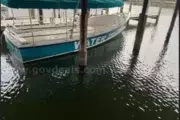Work is scheduled to begin next week on a surface treatment Maryland transportation officials say aims to reduce tractor-trailer crashes on the Capital Beltway’s Outer Loop.
Crews will begin applying an “innovative technique” to the roadway that enhances friction and surface drainage, reducing the risk of hydroplaning and making it easier for vehicles to stop, the Maryland Department of Transportation’s State Highway Administration said in a news release Thursday.
“This project will improve the roadway surface as one strategy to reduce crashes on the Capital Beltway,” MDOT SHA Administrator Tim Smith said in a statement. “This engineering solution will make the roadway safer, especially when coupled with motorists being cautious and obeying posted speed limits.”
The technique involves propelling steel pellets at high velocities toward the pavement, creating a random texture that increases friction between the road surface and a vehicle’s wheels. MDOT cited research suggesting the process improves friction and drainage by about 70%.
MDOT plans to apply the treatment to the Outer Loop between Connecticut Avenue and the Bradley Boulevard overpass, including the driving surface around the notorious “Big Curve” near the Interstate 270 Spur. Last year, lighter traffic and higher speeds at the sharp curve west of Old Georgetown Road led to dozens of crashes involving overturned and jackknifed tractor trailers.
Work to implement the treatment will begin Monday, Feb. 8, with nightly lane closures on the Outer Loop between Connecticut Avenue and the “Big Curve” from 7 p.m. to 5 a.m. the following morning. One lane will close at 7 p.m., then two lanes will close at 8 p.m. every weeknight.
About 30 miles of interstate will undergo the treatment, with work estimated to last until mid-February, weather-permitting.
Maryland has contracted the $460,000 project to Skidabrader, a California-based company MDOT says is one of the few in the U.S. that performs the technique.
WTOP’s Dave Dildine contributed to this report.








